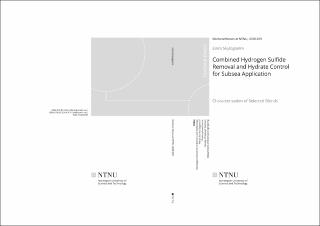| dc.contributor.advisor | Pinto, Diego D. D. | |
| dc.contributor.advisor | Svendsen, Hallvard F. | |
| dc.contributor.author | Skylogianni, Eirini | |
| dc.date.accessioned | 2020-08-07T12:55:41Z | |
| dc.date.available | 2020-08-07T12:55:41Z | |
| dc.date.issued | 2020 | |
| dc.identifier.isbn | 978-82-326-4767-5 | |
| dc.identifier.issn | 1503-8181 | |
| dc.identifier.uri | https://hdl.handle.net/11250/2671228 | |
| dc.description.abstract | After more than a century of oil and gas exploration, fewer and fewer easily accessible reservoirs are available. In order to meet the increasing energy demands, the industry has extended its exploration activities in greater depths and longer distances from the shore, while also focusing its efforts on increasing the efficiency and reducing the environmental footprint of existing and new processes. This work deals with process intensification for natural gas treatment; the combined hydrogen sulfide (H2S) removal and hydrate control for subsea application.
The backbone of this process is the identification of a solvent with this dual function. Aqueous or non-aqueous blends of methyldiethanolamine (MDEA) and monoethylene glycol (MEG), as well as highly concentrated aqueous MDEA are promising regenerative systems. Thus, the objective of this thesis is to characterize these mixtures and gain knowledge of their physical properties and thermodynamic behavior.
Measurements of the physical properties density and viscosity were performed, and predictive models were developed. It was found that considerably high viscosities are encountered for the concentrated amine-glycol systems at the low temperatures relevant to subsea, and that the model developed in this work can be used for the prediction of the viscosity limits of this process.
The thermodynamic behavior of the combined systems proposed was investigated through vapor-liquid equilibrium (VLE) experimental testing at high and low pressures. It was found that high total pressure up to 100 bar has minimal effect on the H2S liquid loading of the solvent, and that the VLE model developed for H2S-MDEA-H2O systems can also predict the equilibrium at methane-containing systems at low total pressures with similar accuracy. In addition, MEG presence in aqueous MDEA leads to lower absorption capacity, manifesting the need for careful choice of MDEA-MEG-H2O composition for this combined process. Further, low-pressure VLE experiments with carbon dioxide and aqueous and non-aqueous MDEA-MEG blends and Nuclear Magnetic Resonance analysis provided important insights on the chemistry of these systems. It was proven that carbon dioxide reacts with MEG in the presence of MDEA, therefore demonstrating the CO2 uptake through chemical absorption.
Based on the findings of this work, an overall evaluation of the technical performance of the studied solvents was conducted for the combined H2S removal and hydrate control, while a holistic approach for solvent development was suggested. | en_US |
| dc.language.iso | eng | en_US |
| dc.publisher | NTNU | en_US |
| dc.relation.ispartofseries | Doctoral theses at NTNU;2020:209 | |
| dc.relation.haspart | Paper 1: Skylogianni, Eirini; Wanderley, Ricardo Ramos; Austad, Sigrid Steinsli; Knuutila, Hanna K. Density and Viscosity of the Non-aqueous and Aqueous Mixtures of Methyldiethanolamine and Monoethylene Glycol at Temperatures from 283.15 K to 353.15 K. Journal of Chemical and Engineering Data 2019 ;Volum 64.(12) s. 5415-5431
https://doi.org/10.1021/acs.jced.9b00607
Copyright © 2019 American Chemical Society | en_US |
| dc.relation.haspart | Paper 2: Skylogianni, Eirini; Mundal, Ingvild; Pinto, Diego Di Domenico; Coquelet, Christophe; Knuutila, Hanna K. Hydrogen Sulfide Solubility in 50 wt.% and 70 wt.% Aqueous Methyldiethanolamine at Temperatures from 283 to 393 K and Total Pressures from 500 to 10000 kPa. Fluid Phase Equilibria 2020 ;Volum 511.
https://doi.org/10.1016/j.fluid.2020.112498
Attribution 4.0 International (CC BY 4.0) | en_US |
| dc.relation.haspart | Paper 3: Skylogianni, Eirini; Perinu, Cristina; Cervantes Gameros, Blanca Y.; Knuutila, Hanna K. Carbon dioxide solubility in mixtures of methyldiethanolamine with monoethylene glycol, monoethylene glycol–water, water and triethylene glycol.
- The final published version is available in Journal of Chemical Thermodynamics 2020 ;Volum 151.
https://doi.org/10.1016/j.jct.2020.106176
Attribution 4.0 International (CC BY 4.0) | en_US |
| dc.title | Combined Hydrogen Sulfide Removal and Hydrate Control for Subsea Application: Characterization of Selected Blends | en_US |
| dc.type | Doctoral thesis | en_US |
| dc.subject.nsi | VDP::Technology: 500::Chemical engineering: 560 | en_US |
